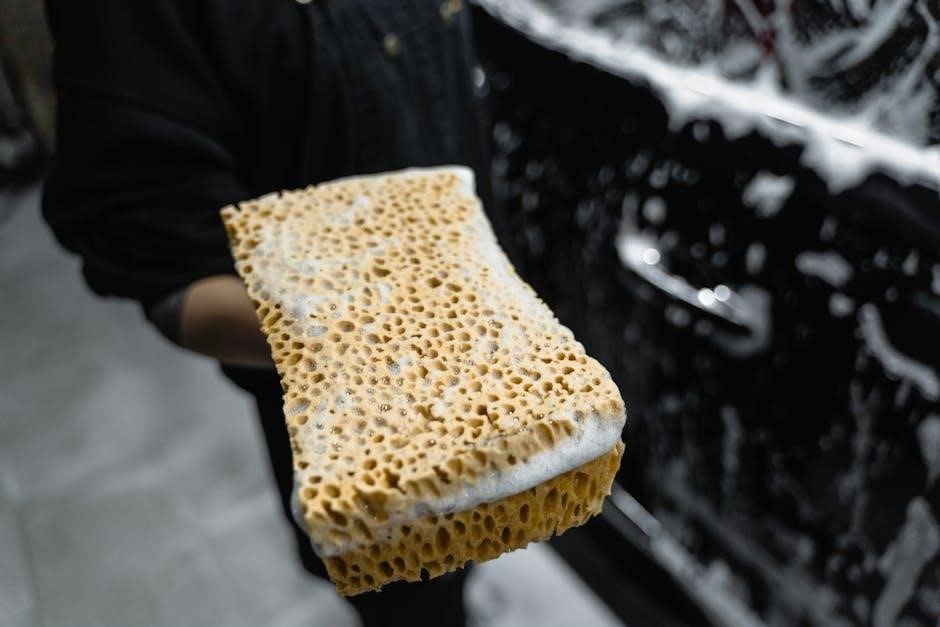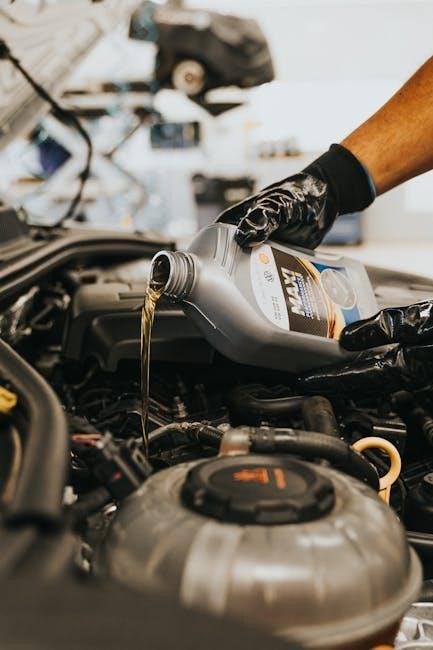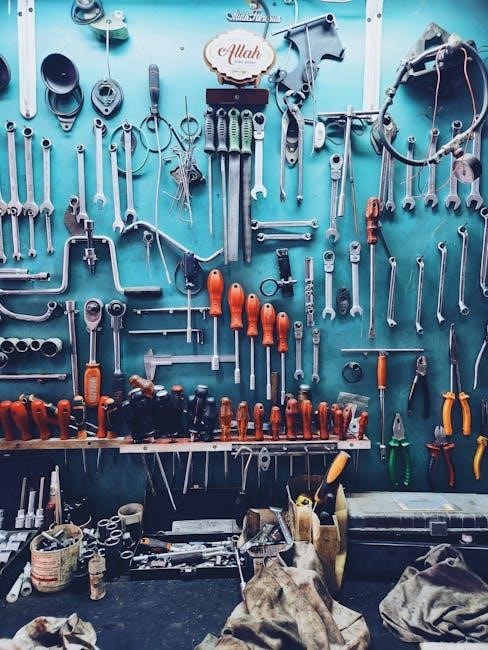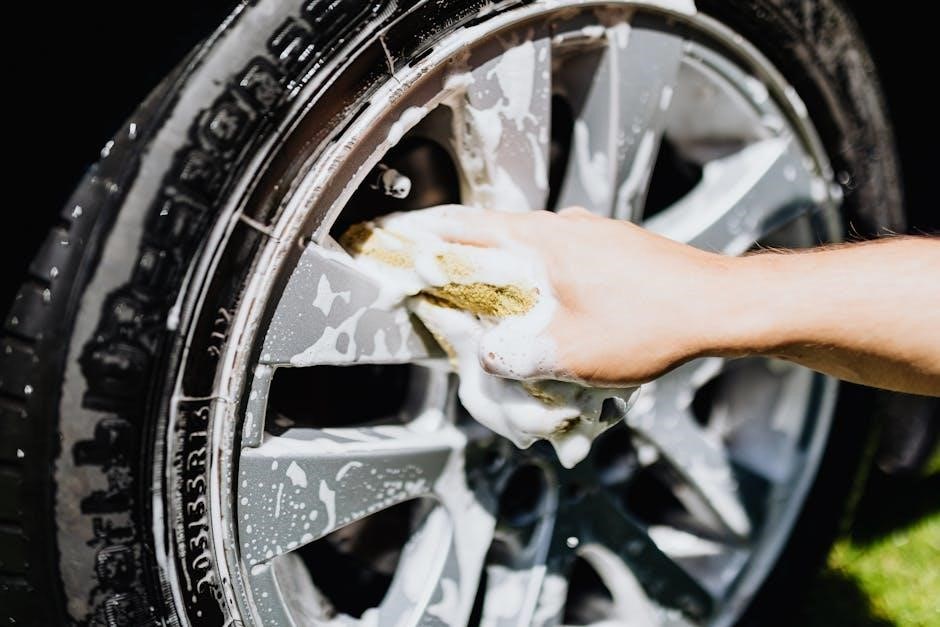Manualized Auto refers to the integration of manual and automatic transmission elements, optimizing performance, efficiency, and driver control. It combines the best of both worlds for enhanced driving experiences.
1.1 Definition of Manualized Auto
A manualized auto combines elements of manual and automatic transmissions, offering drivers enhanced control over gear shifts while maintaining the convenience of automatic functionality. This system allows for manual shifting without a clutch pedal, blending efficiency and driver engagement. It is designed to provide a hybrid driving experience, catering to those who seek both precision and ease. The technology integrates advanced components to optimize performance, making it a versatile option for modern vehicles. This approach ensures a seamless transition between manual and automatic modes, adapting to diverse driving conditions and preferences.
1.2 Purpose and Scope
The purpose of a manualized auto is to bridge the gap between manual and automatic transmissions, offering drivers the freedom to choose their preferred driving style. Its scope extends to enhancing performance, fuel efficiency, and driver engagement while maintaining the convenience of automatic functionality. This technology is designed to cater to a wide range of drivers, from enthusiasts seeking precise control to commuters prioritizing ease of use. By integrating the best of both worlds, manualized autos aim to provide a versatile and efficient driving experience, suitable for various vehicle types and driving conditions.

History of Manual and Automatic Transmissions
Manual transmissions emerged in the early 20th century, offering driver control and efficiency. Automatic transmissions debuted in the 1940s, prioritizing convenience. Both have evolved to meet modern demands.
2.1 Evolution of Manual Transmissions
The manual transmission has evolved significantly since its inception in the early 20th century. Early models featured simple, non-synchronized gears, requiring double-clutching to shift. The 1950s introduced synchronized gears, making shifting smoother and more accessible. Modern manuals incorporate advanced materials, compact designs, and improved gear ratios for better fuel efficiency and performance. Technological advancements, such as automated manual transmissions, have bridged the gap between manual and automatic driving experiences. These innovations ensure manual transmissions remain relevant in today’s automotive landscape, blending tradition with cutting-edge engineering.
2.2 Development of Automatic Transmissions
The development of automatic transmissions began in the 1940s, with General Motors introducing the Hydramatic, the first mass-produced automatic transmission. This innovation replaced manual shifting with a fluid coupling and planetary gears, enabling smooth, driverless gear changes. By the 1950s and 60s, automatics became mainstream, featuring torque converters for improved efficiency. Modern automatics incorporate advanced technologies like lock-up torque converters and multiple gear ratios, reducing fuel consumption and emissions. These advancements have made automatic transmissions a cornerstone of modern vehicles, offering convenience and performance while influencing the concept of manualized autos.
The Process of Manualizing an Auto
Manualizing an auto involves converting an automatic vehicle to a manual transmission system, requiring mechanical expertise, specialized tools, and precise adjustments for optimal functionality.
3.1 Preparation for Conversion
Preparation for manualizing an auto involves assessing the vehicle’s compatibility with manual transmission systems. This includes evaluating the engine’s specifications and ensuring the chassis can support the conversion. Researching the appropriate manual transmission model and gathering necessary tools and parts is essential. Consulting a mechanic or transmission specialist is highly recommended to avoid costly mistakes. Additionally, reviewing technical manuals and understanding local regulations ensures compliance. Proper planning and budgeting are crucial to handle unexpected expenses and labor-intensive processes. A thorough inspection of the vehicle’s current state helps identify potential issues early on, ensuring a smoother conversion process.
3.2 Step-by-Step Conversion Process
The conversion begins with disconnecting the battery and draining fluids to ensure safety. The automatic transmission is then removed, followed by the installation of the manual transmission system. This includes fitting the clutch assembly, gearbox, and shifter mechanism. Wiring and hydraulic systems are adapted to accommodate the new components. The clutch pedal is installed, and linkages are connected. Finally, the vehicle is reassembled, and the new manual system is tested for functionality and performance. Each step requires precision to guarantee reliability and optimal operation of the converted manualized auto.
3.3 Post-Conversion Testing and Adjustments
After conversion, thorough testing is essential to ensure optimal performance. Initial checks involve verifying fluid levels and inspecting for leaks. A test drive assesses clutch engagement, gear shifting smoothness, and overall drivetrain functionality. Acceleration and deceleration are monitored to identify any issues. Adjustments may include fine-tuning the clutch pedal feel, aligning the shifter linkage, and ensuring proper transmission synchronization. If irregularities are detected, mechanical components are recalibrated or replaced. Comprehensive testing guarantees the manualized auto operates efficiently and safely, meeting the driver’s expectations for both performance and reliability.
Benefits of Manualized Auto
Manualized Auto enhances driving experience by combining manual control with automatic ease, improving fuel efficiency and providing cost savings through optimized performance and reduced wear on components.
4.1 Enhanced Driving Experience
A manualized auto offers a unique blend of control and convenience, allowing drivers to engage more deeply with the vehicle. This setup often leads to a more immersive and satisfying driving experience, as it combines the precision of manual shifting with the ease of automatic operation. Drivers can enjoy smoother acceleration and better responsiveness, making every journey feel more dynamic and enjoyable. Additionally, the ability to switch between modes provides flexibility, catering to both relaxed cruising and spirited driving. This adaptability ensures that the driving experience remains engaging and tailored to various preferences and conditions.
4.2 Improved Fuel Efficiency
Manualized auto systems often incorporate features like adaptive gear shifting and smart torque management, which optimize engine performance and reduce fuel consumption. By seamlessly transitioning between manual and automatic modes, these systems ensure that power delivery is efficient, minimizing energy waste. This adaptability allows the vehicle to maintain optimal fuel efficiency during both city driving and highway cruising. The combination of driver control and automated adjustments ensures that fuel usage is maximized, leading to cost savings and reduced environmental impact. This balance of performance and economy makes manualized autos a practical choice for eco-conscious drivers.
4.3 Cost-Effectiveness
Manualized auto systems offer a cost-effective solution by combining the benefits of manual and automatic transmissions. They reduce the need for complex mechanical components, lowering production and maintenance costs. These systems often extend the lifespan of vehicle parts by optimizing wear and tear. Additionally, improved fuel efficiency contributes to long-term savings on fuel expenses. The affordability of manualized autos makes them accessible to a broader market, appealing to budget-conscious consumers. This blend of efficiency and affordability ensures that manualized autos provide significant value without compromising on performance or functionality, making them a financially prudent choice for many drivers.

Drawbacks of Manualized Auto
Manualized auto conversions can be complex, requiring specialized tools and expertise. They may also involve higher labor costs and potential compatibility issues with certain vehicle systems.
5.1 Complexity of Conversion
Converting an automatic vehicle to a manualized auto involves significant technical challenges. It requires specialized tools, advanced mechanical expertise, and a deep understanding of transmission systems. The process often demands custom fabrication, wiring modifications, and software updates to ensure compatibility. Additionally, the conversion may necessitate changes to the vehicle’s electrical and hydraulic systems, further complicating the procedure. The complexity increases with modern vehicles, which rely heavily on computerized controls. These factors make the conversion labor-intensive and prone to potential issues if not executed precisely. As a result, such projects are typically undertaken by experienced professionals rather than amateur mechanics.
5.2 Labor Intensity
Manualized auto conversion is highly labor-intensive, requiring significant time and effort. Each step, from initial assessment to final assembly, demands meticulous attention to detail. Skilled mechanics must dedicate hours to disassembling and reassembling components, ensuring precise alignment and functionality. The process often involves custom fabrication, which further extends the workload. Even experienced professionals may spend considerable time troubleshooting and refining the system. The physical and mental demands of such conversions make them challenging, emphasizing the need for expertise and patience. This labor intensity is a key factor limiting the adoption of manualized autos.
5.3 Compatibility Issues
Manualized auto conversions often face compatibility challenges, as integrating manual and automatic components can be complex. The transmission system must align with the engine, ECU, and drivetrain, which may require custom modifications. Incompatible parts, such as gear ratios or sensors, can lead to poor performance or mechanical failure. Additionally, modern vehicles rely on sophisticated electronics, making it difficult to synchronize manual controls with automatic systems. These compatibility issues demand precise engineering and may necessitate bespoke solutions, increasing both time and cost. Ensuring seamless integration is a significant hurdle in achieving a reliable manualized auto setup.

Technical Considerations
Manualized auto requires precise engineering, focusing on transmission types, component compatibility, and necessary modifications. Proper tools and expertise are essential for a successful conversion, ensuring optimal functionality and safety.
6.1 Types of Transmissions
Manualized autos often involve blending manual and automatic transmissions. Common types include dual-clutch transmissions, continuously variable transmissions (CVT), and automated manual transmissions (AMT). Each offers unique benefits, such as improved fuel efficiency for CVTs or faster shifting with dual-clutch systems. The choice of transmission type depends on the vehicle’s intended use, with performance cars favoring dual-clutch systems and economy-focused vehicles opting for CVTs. Compatibility with existing drivetrains and driver preferences are key considerations in selecting the appropriate transmission for manualization.
6.2 Parts and Tools Required
Manualizing an auto requires specific parts and tools to ensure compatibility and performance. Essential components include gear sets, clutch kits, and adapter plates to integrate manual controls with automatic systems. Specialized tools like torque wrenches, transmission jacks, and hydraulic pressure testers are necessary. Additionally, custom mounts, sensors, and wiring harnesses may be needed for proper installation. High-quality lubricants and seals are crucial to maintain system integrity. Access to diagnostic software and technical manuals can also aid in the process. Proper tools and parts ensure a smooth and safe conversion, minimizing potential issues down the road.
6.3 Necessary Modifications
Manualizing an auto requires several key modifications to ensure proper functionality. The transmission system must be adapted to integrate manual controls, often involving custom mounts and wiring harness adjustments. The engine computer may need reprogramming to synchronize with the new transmission setup. Additionally, modifications to the drivetrain, including gear ratios and clutch systems, are essential for optimal performance. Compatibility issues must be addressed through custom adapters or upgraded components. Structural reinforcements may also be necessary to support the altered weight distribution and stress points. These modifications ensure the vehicle operates smoothly and efficiently in its manualized form.
Legal and Safety Aspects
Modifying a vehicle to manualized auto may pose safety risks and legal challenges. Ensuring compliance with traffic laws and safety standards is crucial to avoid penalties and hazards.
7.1 Regulatory Compliance
Regulatory compliance is a critical aspect of manualized auto modifications. Vehicle owners must ensure that all modifications meet local and federal safety standards to avoid legal penalties. This includes adhering to emissions regulations, braking systems, and electrical components. Failure to comply can result in fines, vehicle impoundment, or even legal action. Additionally, modified vehicles must pass mandatory inspections to remain roadworthy. It is essential to consult with certified professionals and review applicable laws before proceeding with any conversion. Proper documentation and approval from relevant authorities are also necessary to maintain compliance. Always prioritize safety and legality when modifying a vehicle.
7.2 Liability Concerns
Manualized auto conversions can raise significant liability concerns. Owners and technicians must be aware of potential risks, such as mechanical failure or accidents caused by improper modifications. Liability may fall on the person performing the conversion if it results in damage or injury. Additionally, insurance companies may void policies if modifications are not disclosed or approved. Legal implications can arise if the vehicle does not meet safety standards or causes harm to others. Proper documentation, professional installation, and adherence to safety guidelines are crucial to minimize liability risks and ensure legal protection for all parties involved.
7.3 Safety Precautions
Ensuring safety is critical when working on manualized auto conversions. Proper tools and equipment must be used to avoid injuries or damage. Always follow manufacturer guidelines and safety manuals. Wear protective gear, such as gloves and goggles, when handling machinery or electrical components. Testing the vehicle post-conversion should be done in a controlled environment to assess performance and safety. Regular inspections of modified parts are essential to prevent malfunctions. Additionally, drivers should be trained on operating the modified vehicle safely. Adhering to these precautions minimizes risks and ensures a secure driving experience.

Maintenance and Cost Implications
Manualized autos require regular maintenance to ensure optimal performance. Costs include parts replacement and labor fees, but long-term fuel savings can offset initial expenses significantly.
8.1 Maintenance Requirements
Maintenance for manualized autos involves regular checks of transmission fluid, clutch systems, and gear components. Fluid levels must be monitored to prevent overheating, while clutch wear should be inspected to avoid slippage. Filter replacements and seal inspections are crucial to maintain smooth operation. Additionally, torque converter and pressure plate conditions require periodic evaluation. Owners should adhere to a scheduled maintenance plan to ensure longevity and performance. Proper care can significantly reduce long-term repair costs and extend the vehicle’s lifespan.
8.2 Cost of Parts and Labor
The cost of parts and labor for manualized autos can vary significantly, depending on the complexity of the conversion and the components involved. High-performance parts, such as custom clutch kits or specialized gearboxes, can be expensive. Labor costs are also substantial, as the process requires skilled mechanics with expertise in both manual and automatic transmissions. Estimates suggest that parts alone can range from $2,000 to $5,000, while labor can add an additional $3,000 to $6,000. These costs are often higher than those for standard automatic or manual transmissions, making manualized autos a significant investment.
8.4 Long-Term Cost Benefits
Manualized autos offer several long-term cost benefits, primarily due to their fuel efficiency and lower maintenance needs. By combining the best of manual and automatic transmissions, these systems often reduce fuel consumption, leading to savings over time. Additionally, the durability of manual components can result in fewer repair costs compared to traditional automatic transmissions. While the initial investment may be higher, the long-term savings in fuel and maintenance can offset these costs. Furthermore, manualized autos may retain higher resale value due to their unique performance and efficiency advantages, making them a financially sound choice for many drivers.
Future of Manual Transmissions
Manualized autos are expected to evolve with advancing technology, blending traditional manual control with modern automation. Their unique appeal may ensure a niche in future automotive markets.
9.1 Market Trends
Market trends indicate a growing interest in manualized autos, driven by the demand for hybrid and electric vehicles. The integration of manualized systems into modern transmissions is becoming increasingly popular, as it offers a balance between efficiency and driver control. Automakers are investing in research and development to enhance the performance of these systems, catering to environmentally conscious consumers. Additionally, the rise of semi-autonomous vehicles has sparked interest in manualized options, blending traditional driving experiences with advanced technology. This trend is expected to grow, particularly in Europe and Asia, where fuel efficiency and cost-effectiveness are prioritized.
9.2 Technological Advancements
Technological advancements in manualized autos are revolutionizing the automotive industry. Innovations such as dual-clutch transmissions and AI-driven gearbox systems are enhancing performance and efficiency. These systems combine the precision of manual controls with the convenience of automatic shifting, offering drivers unparalleled control. Additionally, advancements in clutch technology and smart shifting algorithms are improving fuel efficiency and reducing wear on components. Electrification of manualized systems is also on the rise, integrating with hybrid and electric vehicles to optimize power delivery. These innovations are driving the evolution of manualized autos, making them more accessible and appealing to modern drivers.
Manualized autos blend manual and automatic transmission benefits, offering enhanced control, efficiency, and performance. This innovative approach is reshaping driving experiences, catering to diverse preferences and needs effectively.
10.1 Summary of Key Points
Manualized auto combines manual and automatic transmission benefits, enhancing driving control and efficiency. It offers improved fuel economy, cost savings, and a more engaging experience. However, challenges like complexity, labor intensity, and compatibility must be addressed. Proper planning, technical expertise, and compatibility checks are crucial for successful conversions. Understanding these factors helps enthusiasts make informed decisions about adopting manualized autos for their vehicles.
10.2 Final Thoughts
Manualized auto represents a unique blend of manual and automatic transmission benefits, offering drivers enhanced control and efficiency. While it presents challenges like complexity and compatibility, the potential for improved performance and cost savings makes it appealing. For enthusiasts seeking a personalized driving experience, manualized auto is worth exploring. However, careful planning and expertise are essential for a successful conversion. As automotive technology evolves, the future of manualized autos remains promising, offering a balance between tradition and innovation for those who value a more engaging and efficient drive.